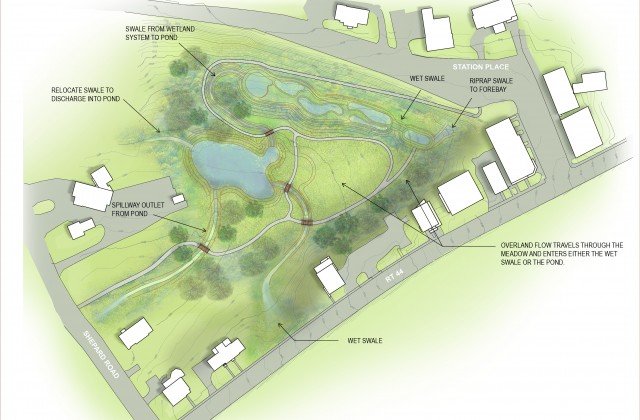Norfolk Awarded $500,000 to Enhance City Meadow
Plan Combines Water Quality and Recreation
By Wiley Wood
A plan to turn the five-acre wetland in the center of Norfolk into a storm-water park has been awarded a $500,000 state grant, Governor Dannell P. Malloy’s office announced on September 17. The projected City Meadow will offer paths, boardwalks and benches for strollers, as well as a stream and settling ponds for the runoff that collects from surrounding roads and flows into the Blackberry River.
In response to the news, Mary Ackerly, chairman of the City Meadow Committee, said, “It’s a huge amount of money. I’m amazed that we got it. It should cover the lion’s share of the costs.” The project’s budget is estimated at $532,000, divided between wetland enhancement and furnishing a recreational park.
First Selectman Sue Dyer, who wrote the successful grant, intends for the project to be paid for entirely by funds other than taxes. “Because it doesn’t benefit everyone in town equally, it seems unfair to put it on the backs of the taxpayers,” says Dyer.
The timeline for completion is uncertain, but Dyer estimates that work will continue into the 2016-2017 fiscal year. The town’s Wetlands Commission has already approved the project, but applications to the Army Corps of Engineers and the Connecticut Department of Energy and Environmental Protection are still pending.
“The town has been talking about what to do with this big piece of real estate in the center of town for decades,” says Jocelyn Ayer, director of the Northwestern Connecticut Regional Collaborative. “State funding will allow this not-very-attractive space to be turned into an amenity for residents and visitors, and have a beneficial environmental impact. It’s win-win.”
Norfolk is one of 13 towns in Connecticut and the only town in Litchfield County to receive a grant from the Main Street Investment Fund, whose purpose is to help towns develop and improve their commercial centers.
In her application, Dyer described the sunken wetland as “currently a hole in the fabric of the village area which requires residents and visitors to drive around.” The City Meadow park, she wrote, would “knit the center of town with the surrounding neighborhoods and businesses.”
The plan calls for a long path that would start from the circular seating area in Station Place, cutting through the stone wall, and slice along the slope in a gentle grade paralleling John J. Curtis Road. It would join at the bottom with paths leading to Shepard Road and Route 44, according to Pete Anderson, an architect on the City Meadow Committee.
“Most of the runoff enters through two pipes in the side of the hill near the Royal Arcanum Building,” says Anderson. The water would first be directed into a rocky forebay at the bottom of the slope, a first-line sediment trap, then turn right and pass through a vegetated set of pools to shake out more sediment. “Next it would curl around and head slightly downhill over a set of low, rocky waterfalls,” says Anderson, “into a deeper pond where the water is ëpolished.'” From the polishing pool, the water would exit the meadow through a conduit under Shepard Road near the fire station.
“We hope people will eventually go there for fun,” says Anderson. “Maybe there will be skating on the deep pool in winter.”
Illustration by Katy Ackerley.

